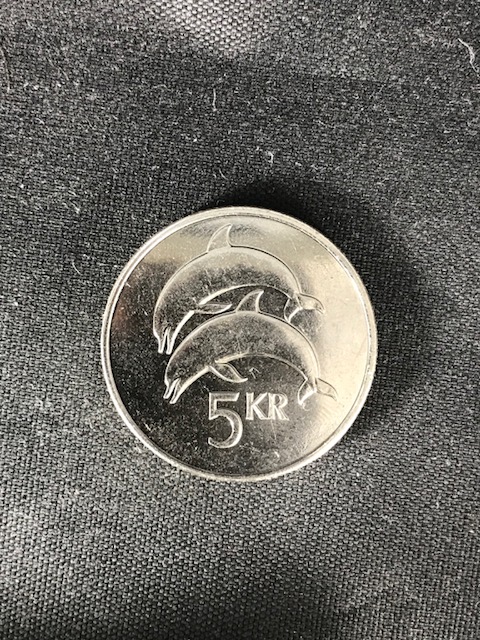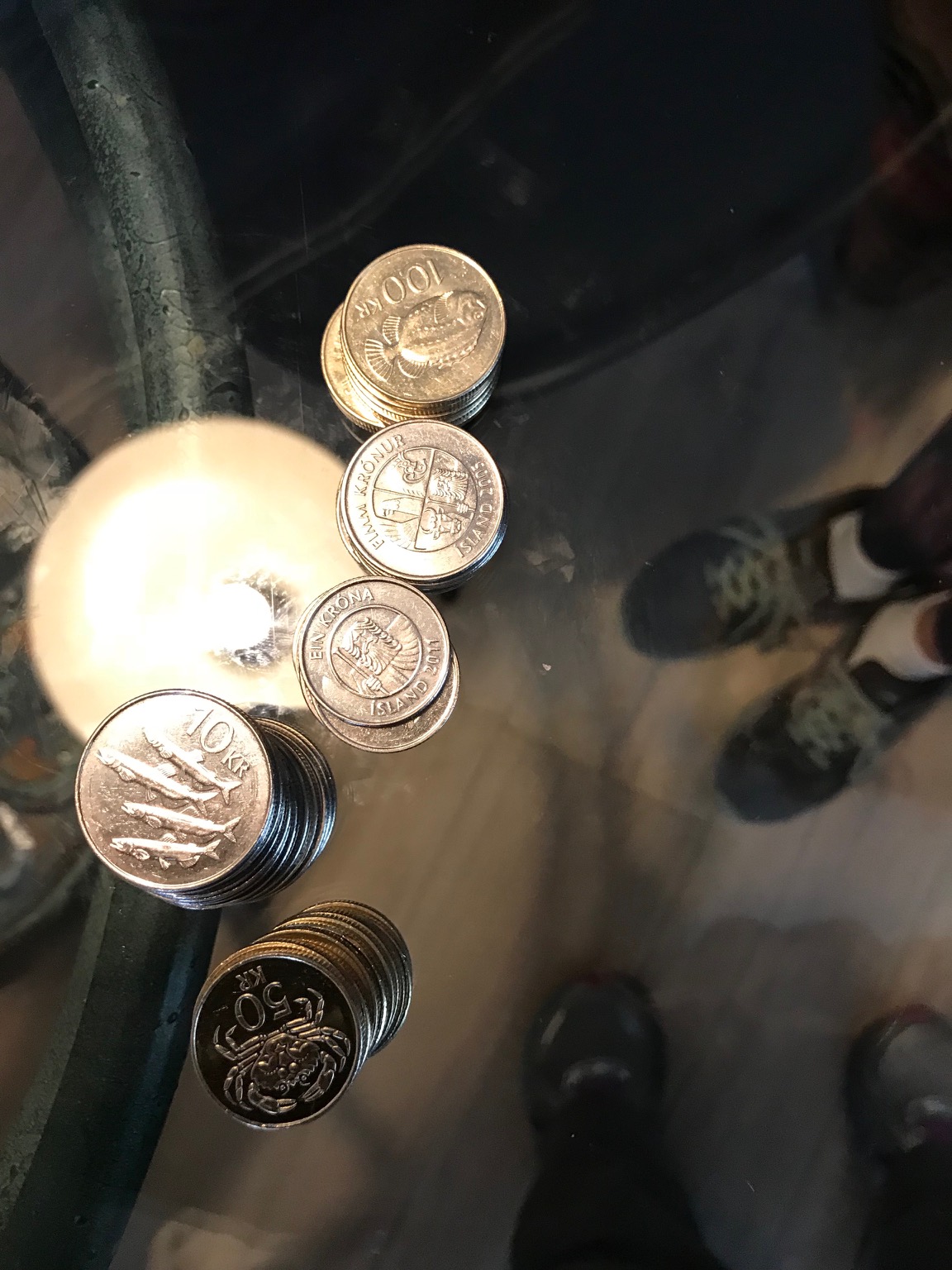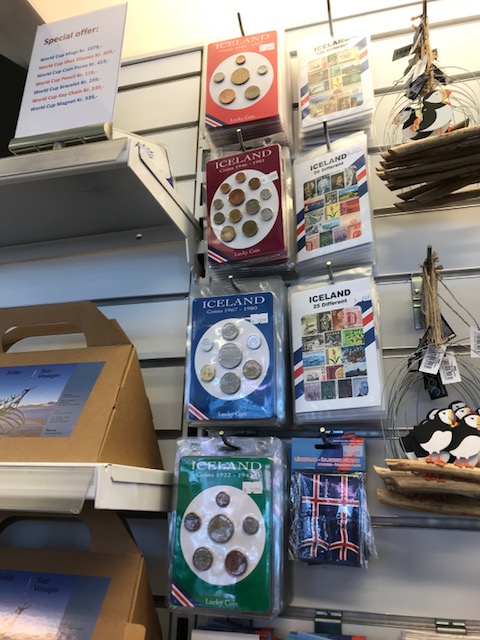
It was a very unusual start for a trip. In a long time, the first time I wasn’t traveling for business. Just recently they introduced a daily flight from Cleveland to Reykjavik. At home we have talked about it, soon after which My daughter, Emily brought home a book from the library about Iceland, and a few days later she started telling people that I’m taking her to Iceland. I had no idea where she got the idea from, but we talked about it with my wife, and it sounded like the perfect vacation idea. As always, I checked if there was a money museum there, and sure enough, there was one.
A few weeks before we left for Iceland, I sent an email to the Numismatic Museum, which is part of the Icelandic National Museum. In a couple of days I got a response that our family is welcome to attend a tour at the Museum at the time of our choosing. This was very generous, especially because we found out that the museum’s curator, Mr. Sigurður Pálmason came in to meet us during his vacation.

I have to say that it seems I have always known of Iceland and it was something far and distant to me. My first encounter was sometime in fifth grade, when we had a large plastic European map, and in the upper left corner there were two little spots of some sort with the letters IL, which meant Iceland. Later I remember learning about the geysers, volcanos, but this was mostly it. Though it always fascinated me, I don’t even know what. Probably the fact that it was so far from everything, and it is mostly an arbitrary decision that it belongs to Europe and not America. Ok, culturally it makes sense, but geographically much less, especially that part of the island belongs to the American tectonic plate. Later as I started traveling, I remember that when the pilot said anything about our route between America and Europe, if only one thing was mentioned it was Iceland. For example, we will be flying above Iceland, or currently we are above Iceland. But nothing more, it only gave me an idea how far it was from Europe. Earlier this summer when I was in Belfast, I was probably closest to it, approximately less than a thousand miles, but this is still a big distance.
When we reserved our trip, I wanted to learn a little more about Iceland. The first thing I wanted to find out is something about the language. I knew it had a Scandinavian heritage, but I didn’t have more of an idea.
Icelandic is mostly related to the Scandinavian languages, but in its archaic form. People in Iceland are able to understand their literature many hundreds of years back. As always, I wanted to learn a few words in Icelandic, I thought it would be something relatively easy, as I learned a few things in Swedish and Danish a few years ago when I was in Denmark. It turned out to be much more complex than what I thought. Icelandic has a few characters which do not exist in Danish. Also, finding a way to read it out with a speech system was challenging, because I was not able to find an Icelandic text to speech system. I did find a description of the braille characters, but without much guidance of pronunciation it didn’t make much sense.
I am ashamed to admit, though originally I planned to, I did not learn much more than yes and no in Icelandic. However, it was also interesting to find that there was no time when I needed Icelandic. As soon as people figured out that we weren’t local, and probably it wasn’t a difficult guess, they switched to fluent English, and it was very easy to communicate. Mr. Pálmason for example apologized for his English, but I don’t think it was any worse than mine after living in the US for many years. And in general it wasn’t anything unusual. It was nice to hear the language though on the streets in real life, it gave me a better idea of what it really sounds like.
It fascinated me how this little country can provide all the necessary knowledge people need. Just for a comparison, a little more than 300 thousand people live in the country, a bit more than half of the people in Cleveland. Outside of the country, not many people speak Icelandic, yet, they have everything a large country has. Schools, at least one university I know of, parliament, stores, banks, entertainers, authors, translators, radio operators, DJs, news broadcasters, and of course, many tour guides.
Another thing that amazed me was the prices. We heard that Iceland wasn’t cheap, but I thought that we have lived in DC and Chicago, and we have seen it all. No, we haven’t… But I also have to say that what we got for our money was always exceptional.
We visited the museum on the third day of our stay, hoping to give the kids a couple of days to adjust to the time difference. Asking to learn about local coins was the best idea. The museum has some 5000 artifacts, but what we have learned about the money of Iceland I couldn’t have found anywhere.
Before the trip, I tried to find some information, I mostly read related articles on Wikipedia and in the Krause Catalog. I did find a list of coins and most notes, but it was nothing more than a list. I have to say, it didn’t even sound interesting, and I was a bit worried what is there in Iceland, as they only introduced coins in 1922. Before that, they used Danish coins according to the resources I found, but we learned from Mr. Pálmason that it was more than that, they had all kinds of different Scandinavian coins, the museum even has a Swedish plate money.
Iceland started to use its own currency earlier, in 1886 they started issuing bank notes, this is when “Iceland” started appearing on currency, so when the first coins came out the Icelandic Krona already existed.
Iceland had three sets of coins, but interestingly after 1944 when they declared independence from Denmark, they did not issue new coins due to the shortage of metal after World War II, so the old coins with the crown were used until the 1970’s, when new coins were issued.
In 1980, a new set of coins became necessary when the Icelandic Kronur was devalued after a heavy inflation. A new inflation hit the currency after 2008, but it wasn’t as big as the previous one.
I had a chance to touch all the coins used in circulation before the current sett. I did get the current coins from the stores before we visited the museum. Needless to say it was the first thing I did. Since I didn’t have too many coins from Iceland, and even those have doubles, the current set of coins were new to me. There are some very nice, large, easy to identify coins. Not only the designs are easy to tell apart, but the edges and sizes are also very distinct.

But back to the older coins. It is interesting that not many coins have remained in good condition, because they were used for several decades, and got completely worn out. Probably the museum has some of the nicest pieces. However, interestingly when the old kronur was withdrawn, some 40 percent of the coins still remained with the people, according to estimates some 490 tons. This may also be because by that time the value of these coins were very little.
Just before visiting the museum, we found a great number of packages of coins at a gift store, labeled as lucky coins. These were coins from anywhere from the 1930’s to the 1970’s for an outrageous price. I left them there assuming that I could get them cheaper somewhere, though it was cool to find real old coins sold in gift stores. After we learned that many of the coins got so worn, I think those prices are more reasonable.

After an overview of the Icelandic coinage, we also got an introduction to the bank notes. We found out that all kinds of different notes were used, three entities officially issued bank notes, the largest being the Bank of Iceland, which was a private entity. Notes came in all colors. People at the bank signed each note individually. The largest bank note originally was a 50 Kronur, which was worth many months of salary at the time. Thus, very few survived, because people used them. There is only one note in private collections, in the bidding war on an auction the price went up so high that some people decided to buy it together to split the costs, and each one of them now holds the note for one year and passes it on.
After the overview of the currency of Iceland, we found out that Mr. Pálmason is working on a project to digitalize the holdings of the museum to make it available online. I am happy to find that more and more museums take this approach. Consequently, if done well, much more information will be available to blind people this way.
It was a fascinating visit. I did not detail here all we have learned, but Mr. Pálmason gave us a very interesting and detailed introduction to the currency of Iceland, the museum is absolutely worth visiting, and we haven’t even seen the majority of the objects. But I am convinced again, that the best way to go is to ask local people about local coins, which they value and understand thoroughly.
Another museum which I would highly recommend to anybody.
Finding the museum
Finding information about the museum is not immediately obvious. When searching for money museum or numismatic museum, mostly tourist sites come up, and based on one of those, we almost went to the wrong address, fortunately I have double checked.
The museum is housed in the Central Bank of Iceland, but owned by the National Museum of Iceland. Here is a page on the Bank’s site to get started, the address here is correct: Kalkofnsvegi 1, 101 Reykjavík.
I have to say, I did not find their web site until after the trip, but when I did, I was delighted to find that they have quite a bit of information available in English. Though I think one should read original documents if possible, reading Icelandic text is more than a challenge for me, so here are all publications listed on the site. There are hundreds of papers in digital format, there is something for the numismatist, historian or the economist.


Last Icelandic coins are dated 2011, has Iceland stop producing coins?
This sounds about right. I know they didn’t have any new coins from 2012 until we were there in 2018, but I’m also not finding any more on Numista. As I understand they are just using the older coins in circulation, the currency hasn’t changed. This may also be due to the increased credit card use, which is probably the most preferred method of payment. When we were there, there was no need to use cash anywhere, we simply chose to.